Water Accounting in Use webinars | 2019
Summary of Water Accounting Webinar Series Part 1: "Online training on the basics of Water Accounting"
The objective of the Water Accounting Webinar Series Part 1 is therefore to get all parties to share the same understanding on key concepts and tools. This training is useful for decision makers, development practitioners, government officials, academics, or anyone interested in water accounting and its concepts and tools. Prior knowledge on the topic is a plus but is not required. The learning goals of this training are: to be able to discuss Water Accounting, gain knowledge and insight on the use of water accounting through case studies from around the world and the NENA region, understand how to implement the first cycle of water accounting also called “a Rapid Water Accounting” exercise based on existing information and data, and discover the different water accounting approaches and set of tools to select from to implement water accounting. The online training is organized in a series of webinars, and knowledge of participants are checked by quizzes during and after each session.
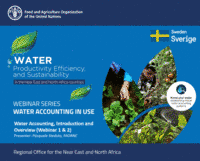
Webinar 1 & 2 Summary: Water Accounting, Introduction and Overview
In this collection of Webinars, Dr. Pasquale Steduto delves into the definition, principles and uses of Water Accounting. In addition, the key terms often used in water accounting (water efficiency & water productivity) are introduced with supporting illustrative examples. The principles of water sustainability and risk of making decisions without proper water accounting are addressed by an Irrigation modernization case study from Australia. Water auditing is defined with an explanation on how it is related with water accounting. Moreover, a step by step process in strategic planning of water is provided and finally, the main water accounting tools and methods are explained.
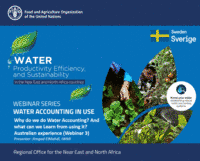
Webinar 3 Summary: Why do we do Water Accounting? And what can we Learn from using it? Australian experience
In this Webinar, Dr Amgad Elmahdi (Head of Middle East North Africa (MENA) Region - International Water Management Institute-IWMI) explains the reasons for using water accounting as a tool. An introduction on IWMI and its activities are given. This is followed by an introduction to water accounting and its main elements including the reasons why water accounting is needed. In addition, the Questions that can be answered by water accounting are highlighted. The Australian case study was used to explain how water accounting is crucial to help alleviate the water security crisis there. The benefits and limitations of water accounting are mentioned. This is finalized with a water accounting road map that is recommended for the NENA-WEPS countries to develop a tailor-made water accounting system.
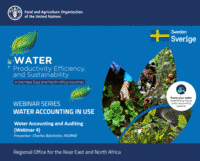
Webinar 4 Summary: Water Accounting & Auditing (WA&A), a brief overview
In this Webinar, Charles Batchelor (in English) and Jean Marc Faures (in French) provide a brief overview into the FAO WA&A Sourcebook that contains lessons learned by FAO and the tools and methods that are well proven to be effective. WA&A terminologies are defined such as different aspects of WA&A as well as the FAO framework and how water accounting and water auditing activities are integrated. Furthermore, WA&A implementation strategies are explained and finally, a case study from south India is provided to demonstrate how WA&A tools can be utilized.
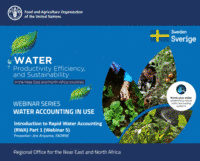
Webinar 5 Summary: Introduction to Rapid Water Accounting (RWA) Part 1
In this Webinar, Jiro Ariyama (FAO Regional Office for Near East and North Africa) provides a background on what is RWA, preparatory steps to take in RWA such as identifications of key questions, stakeholders, spatial and temporary boundary of the study. The different spatial and temporal scales and their relations with key questions are explained. In addition, the suggested contents of RWA are described that includes important considerations such as the level the detail and the data sources. The Resource Infrastructure Demand Access (RIDA) framework and perceptual diagram. The webinar is finalized with a review of different categories of water uses and pathways and examples on how a use/pathway can be categorized differently in farm and basin scale analysis.
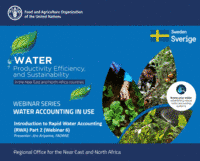
Webinar 6 Summary: Introduction to Rapid Water Accounting (RWA) Part 2
In this Webinar, Jiro Ariyama (FAO Regional Office for Near East and North Africa) continues from the preceding webinar by introducing the concept of the water budget and conducting exercise with the participants. The reasons why water budgets are developed as well as the common errors and challenges associated with it are explained. A case study from Sacramento (California, USA) is also given to demonstrate comparisons between water inflow and outflow. Finally, a guide on uncertainty assessment is provided that includes the importance of the level of uncertainties as well as feasibility to reduce the uncertainties.

Webinar 7a Summary: Rapid Water Accounting (RWA) for Al-Mashare area in Jordan Valley
In this Webinar, Jawad Al-Bakri (Jordan University), a consultant for WEPS in Jordan, explains Rapid and Comprehensive Water Accounting objectives for the Jordan Valley (JV) followed by an introduction of Al Mashare zones 13 and 14 that are the study areas of the RWA. Al Mashare had problems of water shortage in the light of existing cropping pattern and illegal access to water resources. The methodologies and calculation results of water supply to the farms of the JV by the King Abdullah Canal (KAC) and agricultural water demand are explained. This is finalized with the potential of a planned water-harvesting pond to reduce the supply-demand gap in the study area.

Webinar 7b Summary: Rapid water accounting (RWA), Jenin, case Study
In this Webinar, the Palestinian national Water Accounting team of the WEPS describes the RWA that was undertaken in the Al Moqatta3 Jenin study area. Jenin, like other areas in the West Bank, has limited water resources due to small allocation of groundwater under the Oslo Agreement and absence of surface water infrastructure. As such, a description of the study area was given, followed by a description of the issues related to water sustainability the Palestinian agricultural sector faces. Information on water resources, demand and supply in Al Moqatta3 study area is provided. The webinar concluded with a summary of the findings of the RWA for Al Moqatta3, and the need to efficiently utilize the surface water runoff and treated wastewater to cope with the increasing water demand is stressed.
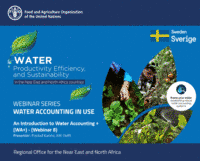
Webinar 8 Summary: An Introduction to Water Accounts Plus (WA+)
In this Webinar, Poolad Karimi (IHE Delft Institute for Water Education) provides an overview on water accounting (WA) and how WA+ framework integrates features of the other WA frameworks. The features, inputs and outputs of WA+ are explained, and an introduction to the case study of WA utilizing WA+ framework for the Urmia Lake Basin in Iran is provided. The Urmia Lake surface area has declined since the 80s, and need water accounting to recover the lake. The results of WA+ application include high evaporation loss (=non-beneficial) especially in rainfed agriculture and rangelands, high consumption from orchards, and nearly the same level of ET between rainfed agriculture and rangelands. Based on the findings, possible interventions, such as reduction of evaporation by mulching, conservation agriculture etc., and improvement of water management in orchards and summer crops, are recommended.
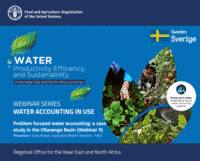
Webinar 9 Summary: Problem focused water accounting: a case study in the Okavango Basin
In this Webinar, Livia Peiser (Technical Officer, Land and Water Division, FAO) provides an example of a problem focused water accounting in the transboundary Okavango Basin in Southern Africa. The Okavango Basin had problems with greater variation and reduction of hydrological flow, changes in sediment dynamics, changes in water quality, and changes in the abundance and distribution of biota. This water accounting intends to better quantify quantity and timing of agricultural withdrawals and their consumptive fraction as well as strengthening technical capacity for shared basin-wide planning. A description of the basin’s hydrological, economic and environmental properties is offered. An overview of the scenario building exercise was given and then concluded with the final results of the WA and scenario exercise. Some key findings such as that Low, Medium, and High development scenarios, would increasingly and significantly reduce the income that people in the basin and its associated economies could derive from natural resources as compared to present day conditions. Her recommendations for WA implementation include developing strategy for scenario building beforehand and choosing suitable tools and approaches considering host institutions and capacities.

Webinar 10 Summary: Australian National Water Accounts Models and Tools
In this Webinar, Dr. Amgad Elmahdi (Head of MENA Region International Water Management Institute-IWMI) provides a recap of Water Accounting (WA) and how it was applied to Australia in addition to the benefits and limitations of the Australian WA system. One of the reasons to do WA was that regions selected had water market activity, and pressure on water resources. The Australian Water Resource Assessment Model (AWRA) with the components (calibration/validation testbed, benchmarking, and operationalization) are described. This is followed through with an introduction to the Australian Water Accounting Standard and its development process. The data requirements, gaps and models of the Australian Water Accounting Standard are explained. And finally, the Australian Water Resource Assessment (AWRA) modelling system is introduced and demonstrated to simulate the changes in Australia’s water balance. It was recommended that WA needs to be guided by standards, using data and combine hydrological and financial models.
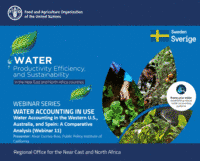
Webinar 11 Summary: Water Accounting in the Western U.S., Australia, and Spain: A Comparative Analysis
In this Webinar, Alvar Escriva-Bou (Research fellow, Public Policy Institute of California) provides a comparative analysis on water accounting between California (United States), Australia and Spain by delving into the motivations as to why such an analysis took place. This analysis was conducted as the recent droughts has exposed weaknesses in availability of water information in California. The problem that California’s water supply is institutionally fragmented even though it is physically interconnected is clearly identified. He also explains the vulnerability of Californian water supply to droughts. This is followed by a methodology and lessons that can be learned from neighboring states. An overview on water accounting is provided followed by the comparative analyses between California, Australia and Spain that account for water availability, rights, use and managing water information. This is finalized with recommendations on California’s water accounting priorities such as, improving allocation of surface water, enhancing groundwater management, strengthening environmental water management, and expanding water trading opportunities.

Webinar 12 Summary: AQUASTAT: accounting water for the SDG 6.4 indicators
This webinar by Virginie Gillet (FAO) provides an overview on AQUASTAT that includes its history, website and its database as a global source of water statistics. She demonstrated how AQUASTAT can be used to carry water resources assessment through the water resources sheet, fact sheet and irrigation sheet. This is succeeded by highlighting the challenges in managing AQUASTAT such as irregular & uneven availability of updates from different countries. Monitoring of SDG Target 6.4 relies, to a large extent, directly or indirectly on data, guidelines and methodologies developed and provided by AQUASTAT.The results of the AQUASTAT questionnaire, which aims to provide a comprehensive picture of water resources and uses at the national level is provided as well as the SDG 6.4.1 calculation tool that is automatically filled in from data compiled in “National data” worksheets.
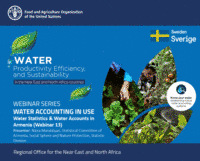
Webinar 13 Summary: Water Statistics & Water Accounts in Armenia
In this webinar, Naira Mandalyan (Statistical Committee of Armenia, Social Sphere and Nature Protection, Statistic Division) introduces the water account and statistics of Armenia, which were developed using various guides on water accounting and statistics, such as System of Environmental-Economic Accounting for Water (SEEAW). She explains the institutional framework of the water accounting including the environmental data exchange agreements and data streams of Armenia. This is followed by an administrative statistical report that includes some key water indicators. In addition, the results of a joint questionnaire on inland waters is given. The questions from the questionnaire were based on gathering data from local stakeholders such as renewable water resources, freshwater abstraction by source & sector, water made available for use, and population connected to wastewater treatment plants. Finally, she presents the System of Water Satellite Accounts in Armenia that cover the physical water supply and uses as well as the economic information associated with water use. She explains the system’s strengths such as its focus on the economic angle and weaknesses such as environment-to-environment flows that are not being taken into account.
